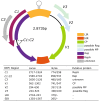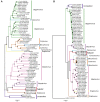Tomato Apical Leaf Curl Virus: A Novel, Monopartite Geminivirus Detected in Tomatoes in Argentina
- PMID: 29375528
- PMCID: PMC5770407
- DOI: 10.3389/fmicb.2017.02665
Tomato Apical Leaf Curl Virus: A Novel, Monopartite Geminivirus Detected in Tomatoes in Argentina
Abstract
Plant viruses that are members of the Geminiviridae family have circular single-stranded DNA (ssDNA) genome and are responsible for major crop diseases worldwide. We have identified and characterized a novel monopartite geminivirus infecting tomato in Argentina. The full-length genome was cloned and sequenced. The genome-wide pairwise identity calculation that resulted in a maximum of 63% identity with all of other known geminiviruses indicated that it is a new geminivirus species. Biolistic infected plants presented interveinal yellowing, apical leaf curling and extreme root hypotrophy. Thus, the name proposed for this species is tomato apical leaf curl virus (ToALCV). The phylogenetic inferences suggested different evolutionary relationships for the replication-associated protein (Rep) and the coat protein (CP). Besides, the sequence similarity network (SSN) protein analyses showed that the complementary-sense gene products (RepA, Rep and C3) are similar to capulavirus while the viron-sense gene products (CP, MP and V3) are similar to topocuvirus, curtovirus and becurtovirus. Based on the data presented, ToALCV genome appears to have "modular organization" supported by its recombination origin. Analyses of the specificity-determining positions (SDPs) of the CP of geminiviruses defined nine subgroups that include geminiviruses that share the same type of insect vector. Our sequences were clustered with the sequences of topocuvirus, whose vector is the treehopper, Micrutalis malleifera. Also, a set of the highest scored amino acid residues was predicted for the CP, which could determine differences in virus transmission specificity. We predict that a treehopper could be the vector of ToALCV, but transmission assays need to be performed to confirm this. Given everything we demonstrate in this paper, ToALCV can be considered a type member of a new putative genus of the Geminiviridae family.
Keywords: Argentina; ToALCV; coat protein; recombination; sequence similarity network; specificity-determining positions; tomato; treehopper.
Figures






Similar articles
-
First Report of Tomato yellow leaf curl virus in Tomato in Costa Rica.Plant Dis. 2014 May;98(5):699. doi: 10.1094/PDIS-08-13-0881-PDN. Plant Dis. 2014. PMID: 30708517
-
Taino Tomato Mottle Virus, a New Bipartite Geminivirus from Cuba.Plant Dis. 1997 Sep;81(9):1095. doi: 10.1094/PDIS.1997.81.9.1095C. Plant Dis. 1997. PMID: 30861977
-
Isolation and characterization of a novel geminivirus from parsley.Virus Res. 2020 Sep;286:198056. doi: 10.1016/j.virusres.2020.198056. Epub 2020 Jun 25. Virus Res. 2020. PMID: 32593914
-
Geminiviruses: Taxonomic Structure and Diversity in Genomic Organization.Recent Pat Biotechnol. 2020;14(2):86-98. doi: 10.2174/1872208313666191203100851. Recent Pat Biotechnol. 2020. PMID: 31793424 Review.
-
Alfalfa Leaf Curl Virus: an Aphid-Transmitted Geminivirus.J Virol. 2015 Sep;89(18):9683-8. doi: 10.1128/JVI.00453-15. Epub 2015 Jun 24. J Virol. 2015. PMID: 26109720 Free PMC article. Review.
Cited by
-
A Temporal Diversity Analysis of Brazilian Begomoviruses in Tomato Reveals a Decrease in Species Richness between 2003 and 2016.Front Plant Sci. 2020 Aug 6;11:1201. doi: 10.3389/fpls.2020.01201. eCollection 2020. Front Plant Sci. 2020. PMID: 32849745 Free PMC article.
-
New World Cactaceae Plants Harbor Diverse Geminiviruses.Viruses. 2021 Apr 16;13(4):694. doi: 10.3390/v13040694. Viruses. 2021. PMID: 33923787 Free PMC article.
-
Analysis of a new begomovirus unveils a composite element conserved in the CP gene promoters of several Geminiviridae genera: Clues to comprehend the complex regulation of late genes.PLoS One. 2019 Jan 23;14(1):e0210485. doi: 10.1371/journal.pone.0210485. eCollection 2019. PLoS One. 2019. PMID: 30673741 Free PMC article.
-
Identification of a Novel Geminivirus in Fraxinus rhynchophylla in Korea.Viruses. 2021 Nov 28;13(12):2385. doi: 10.3390/v13122385. Viruses. 2021. PMID: 34960653 Free PMC article.
-
Olea Europaea Geminivirus: A Novel Bipartite Geminivirid Infecting Olive Trees.Viruses. 2021 Mar 15;13(3):481. doi: 10.3390/v13030481. Viruses. 2021. PMID: 33804134 Free PMC article.
References
-
- Andrade E. C., Manhani G. G., Alfenas P. F., Calegario R. F., Fontes E. P., Zerbini F. M. (2006). Tomato yellow spot virus, a tomato-infecting begomovirus from Brazil with a closer relationship to viruses from Sida sp., forms pseudorecombinants with begomoviruses from tomato but not from Sida. J. Gen. Virol. 87 3687–3696. 10.1099/vir.0.82279-0 - DOI - PubMed
LinkOut - more resources
Full Text Sources
Other Literature Sources
Miscellaneous

